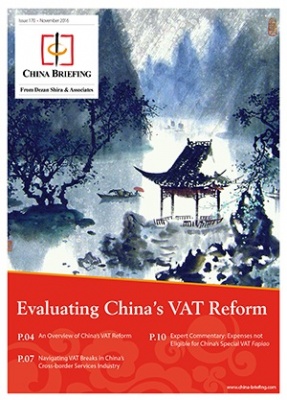
Evaluating China's VAT Reform
Published: November 2016At the beginning of 2012, China began a massive overhaul of its tax system by initiating the replacement of business tax (BT) with value-added tax (VAT). Prior to the reform, VAT was levied only on the sale and import of tangible goods and on the provision of processing, repair, and replacement services, while BT was levied on the provision of all other services as well as the transfer of intangibles and property. As of May 2016, VAT has taken over almost all of BT's various functions, and is now effectively China's only form of consumption tax. In this edition of China Briefing, we walk readers through some of the most salient aspects of the VAT reform affecting foreign businesses in China.
No. of Pages: 12 pages
In this issue:
- An Overview of China's VAT Reform
- Navigating VAT Breaks in China's Cross-border Services Industry
- Expert Commentary: Expenses not Eligible for China's Special VAT Fapiao
At the beginning of 2012, China began a massive overhaul of its tax system by initiating the replacement of business tax (BT) with value-added tax (VAT). Prior to the reform, VAT was levied only on the sale and import of tangible goods and on the provision of processing, repair, and replacement services, while BT was levied on the provision of all other services as well as the transfer of intangibles and property. As of May 2016, VAT has taken over almost all of BT's various functions, and is now effectively China's only form of consumption tax.
The importance of China's VAT reform should not be underestimated. Understanding the workings of VAT is crucial to the success of both existing and newly incorporated China businesses, as failure to build a tax structure around the reform can easily result in a disproportionate tax burden, or in a company being fined or even blacklisted. Navigating the reform can be a particular challenge for US-based investors, who are typically unfamiliar with VAT systems.
In this edition of China Briefing, we walk readers through some of the most salient aspects of the VAT reform affecting foreign businesses in China. We begin by detailing the key features of the reform, including how some of its main rates compare to the previous BT rates, and then examine how the new VAT system can benefit businesses engaging in cross-border services in China – a rapidly rising segment of the country’s economy. Finally, we explain which expenses are not eligible for China’s idiosyncratic “special VAT fapiaos”.
The enormous scale of China’s VAT reform necessarily means that not all of its myriad features can be assessed in this magazine. For readers looking for more information on other parts of the reform, please contact the tax experts at Dezan Shira or consult some of the related content we have available our China Briefing website.

